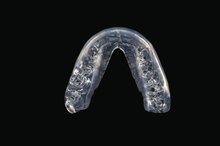How to Glue Broken Dental Plastic
Even though it’s made to be a strong yet flexible material, dental plastic can sometimes get broken. Items such as removable retainers, mouth guards, dentures and other orthodontic and dental appliances are most susceptible to breakage--particularly appliances used by kids who may not always keep track of them when not in use. While some types of breakage are beyond any type of practical repair, there are a few ways to glue broken dental plastic and fix simple breaks 1.
Assess the broken dental plastic to determine if any pieces chipped off during the break. Check for any jagged edges that might cut the mouth.
How to Glue Broken Dentures
Learn More
Use a nail file to gently file down any edges. File each section of the break in the same direction so the pieces will fit snugly together.
Use a toothbrush to gently wash the surface of the broken dental plastic. Remove any residual plastic shards that may have splintered off.
Side Effects of Dental Veneers
Learn More
Select a strong-bonding acrylic dental or plastic glue that is non-toxic. Read the instructions carefully to determine the amount of glue to use and how long it will take to dry.
Dry the broken dental plastic with a hair dryer on low heat, taking care not to melt the plastic.
Cover the work surface and put on plastic gloves. Practice putting the pieces of broken dental plastic to be glued together to ensure a tight fit. If the fit is good, apply a thin line of glue to one side of the broken dental plastic and gently push the two pieces together. Wipe away any residual glue that comes through the crack.
Hold the pieces of glued dental plastic together for the amount of time indicated on the glue manufacturer's label. Once the pieces are firmly secured, set the glued dental plastic on a clean, dry surface and allow the glue to cure for the time specified on the label.
Scrape any excess dried glue from the appliance and file down any remaining ridges or raised spots. Wash thoroughly with a toothbrush and allow to air dry.
Fit the piece into the mouth to test the fit. If it feels odd, remove it, dry it and re-file any uncomfortable edges.
Warnings
Most dental appliances are custom-made to fit an individual’s mouth, so any break in the appliance should be checked by a dentist or orthodontist to ensure the dental plastic is fitting and functioning as it should.
Related Articles
Warnings
- Most dental appliances are custom-made to fit an individual's mouth, so any break in the appliance should be checked by a dentist or orthodontist to ensure the dental plastic is fitting and functioning as it should.
Writer Bio
Lisa McQuerrey has been a business writer since 1987. In 1994, she launched a full-service marketing and communications firm. McQuerrey's work has garnered awards from the U.S. Small Business Administration, the International Association of Business Communicators and the Associated Press. She is also the author of several nonfiction trade publications, and, in 2012, had her first young-adult novel published by Glass Page Books.









